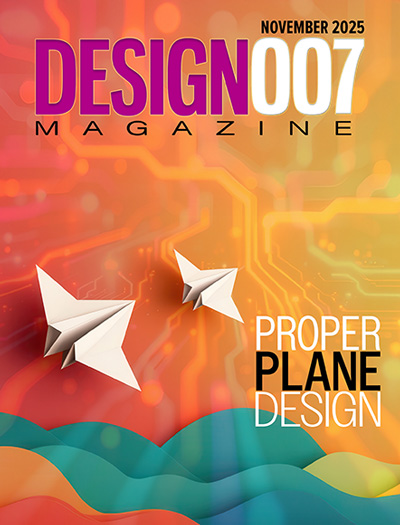-

- News
- Books
Featured Books
- design007 Magazine
Latest Issues
Current Issue
Designing Proper Work-Life Balance
In this issue, we hear from designers, marketers, and business owners on how they apply their professional skills to their personal lives to build a healthier work-life balance.

Designing Proper Planes
Without planes, designers would have to create thousands of traces to accomplish the same objectives. Power planes provide low impedance and stable power, and ground planes stabilize reference voltage, improve thermal performance, and help preclude EMI issues.

Power Integrity
Current power demands are increasing, especially with AI, 5G, and EV chips. This month, our experts share “watt’s up” with power integrity, from planning and layout through measurement and manufacturing.
- Articles
- Columns
- Links
- Media kit
||| MENU - design007 Magazine
Design Considerations: Flexible Circuit vs. Traditional PCB
May 7, 2015 | John Talbot, Tramonto CircuitsEstimated reading time: 1 minute
Recent global printed circuit market research reveals that flexible circuits still only account for about 13–15% of the overall printed circuit market (PCB 76.2B in 2015 vs. flex 12.7B in 2015). PCBs have been in existence since the 1960s and nearly anybody who designs printed circuits first designs a rigid printed circuit board. There are many experienced PCB designers working confidently all around the world.
They understand the manufacturing capabilities and limitations very well as they have been designing these inherent components of the electronics industry for decades.
Flexible circuits, on the other hand, tend to be a little intimidating and mysterious to traditional PCB designers. Suddenly engineers in the development group are coming to their designers with questions about flexible circuits and these otherwise very experienced men and women find themselves without answers to questions they could answer in their sleep if they pertained to a traditional PCB.
It’s understandable that there are still questions about flexible circuit design vs. traditional PCB design based on the number of PCBs vs. flexible circuits manufactured worldwide, annually. However those of us in the flexible circuit fabrication market are often asked even the simplest of questions: what kind of software do I need to design a flexible circuit?
What kind of files must I submit for quotation/fabrication of a flexible circuit? These are questions that arise from the lack of experience in flexible circuit design. Below we will address some of the common concerns we hear from PCB designers and help to clarify some of the unknowns and show that the vast experience gained as PCB designers carries over to the flexible circuit design as well.
To read the full article, click here.
Editor's Note: This article originally appeared in the April 2015 issue of The PCB Magazine.
Testimonial
"Advertising in PCB007 Magazine has been a great way to showcase our bare board testers to the right audience. The I-Connect007 team makes the process smooth and professional. We’re proud to be featured in such a trusted publication."
Klaus Koziol - atgSuggested Items
Pan-European Electronics Design Conference Returns Better Than Ever
12/11/2025 | I-Connect007 Editorial TeamFollowing a highly successful inaugural event, the Pan-European Electronics Design Conference (PEDC) returns, this time to Prague, Czech Republic, Jan. 21–22, 2026. In this Q&A, Peter Tranitz, the Global Electronics Association’s senior director of technology solutions, shares the value of attending PEDC, which aims to bring together PCB designers from across Europe to learn, network, and share their own knowledge.
Quilter Unveils World’s First Computer Designed by AI
12/10/2025 | BUSINESS WIREQuilter, the physics-driven AI for electronics design, announced the world’s first computer designed by artificial intelligence.
December 2025 Design007 Magazine: Designing Your Work and Your Life
12/08/2025 | I-Connect007 Editorial TeamEvery PCB design is a lesson in balance: speed vs. stability, density vs. clarity, performance vs. cost. What if we approached life with that same mindset? In the December issue of Design007 Magazine, we go beyond board design to show how designers, marketers, managers, and owners apply their professional skills to personal choices—and what it costs when that system is left to drift.
Siemens Partners with Certus Semiconductor to Advance AI-Driven Analog and IO/ESD Design
12/04/2025 | SiemensSiemens, a leading industrial technology company, announced that Certus Semiconductor has adopted Solido™ software for custom integrated circuit (IC) design to accelerate development of Input/output (IO) and Electrostatic Discharge (ESD) library solutions for the automotive, aerospace, mobile, consumer electronics industrial, AI and IoT applications.
Real Time with... productronica 2025: Polar on Understanding Material Libraries in Design
12/04/2025 | Real Time with...productronicaPete Starkey and Martyn Gaudion discuss the rapid updates in material libraries and the critical need for designers to grasp material properties. They highlight the role of suppliers and the importance of communication between designers and fabricators. Martyn focuses on the educational aspect of their services, aiming to connect design and manufacturing. The conversation underscores the significance of material knowledge in enhancing the design process through collaboration.


